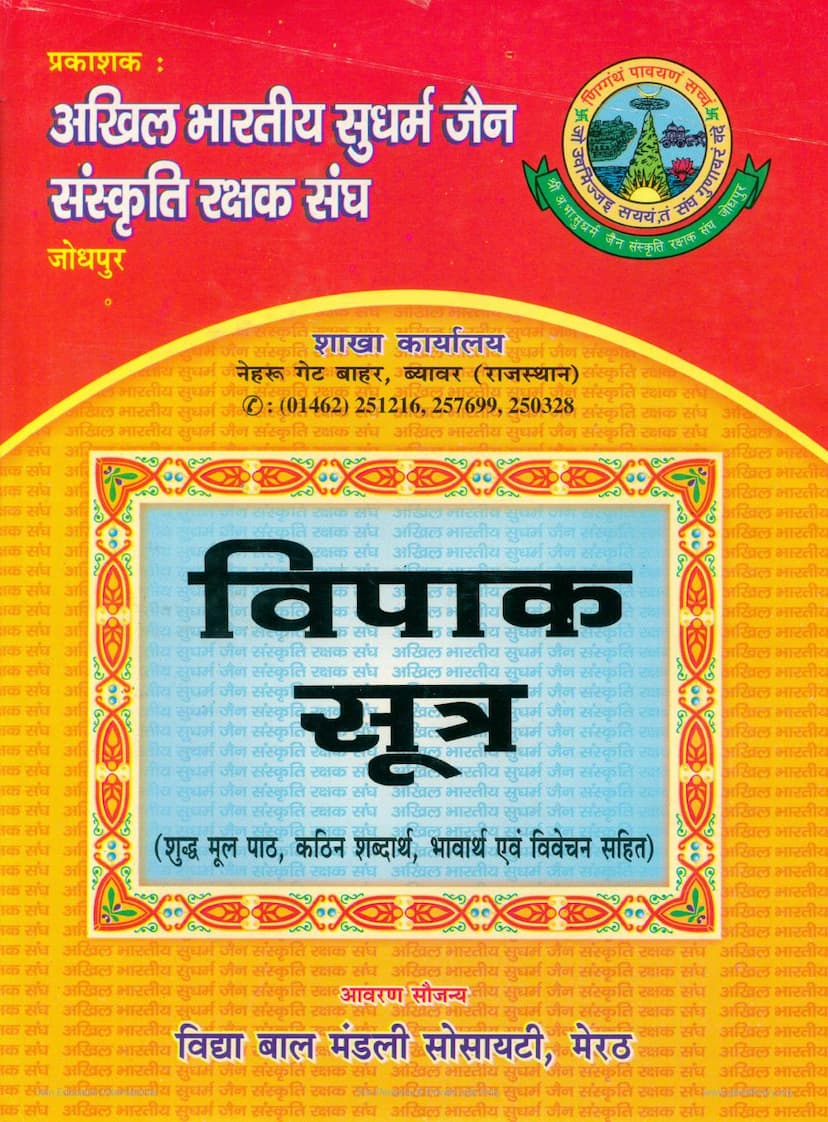Vipak Sutra
Added to library: September 2, 2025

Summary
Here's a comprehensive summary of the provided text, the Vipak Sutra, based on the provided pages:
Vipak Sutra: A Summary
The Vipak Sutra is an important Jain scripture, classified as the eleventh Anga (limb) of the Jaina canon. It delves deeply into the fundamental Jain principle of Karma, explaining the consequences and results of actions, known as "Vipaka" or "Phala" (fruit). The text emphasizes that individuals are the sole doers and enjoyers of their actions, and no external force dictates their destiny.
Core Concepts Explained:
- Karma and its Results (Vipaka): The central theme of the Vipak Sutra is the detailed exposition of karma theory. It clarifies that the results of actions, whether good (punya) or bad (papa), manifest at different times, leading to happiness (sukha) or suffering (duhkha) in the cycle of birth and death (samsara).
- Dukha-Vipaka (Unhappy Results): This section, comprising ten chapters (adhyan), illustrates the adverse consequences of negative actions. Through narratives of ten individuals, it shows how actions like violence, falsehood, theft, misconduct, and attachment lead to suffering in various forms, including rebirth in lower realms, physical and mental afflictions, loss of reputation, and unfortunate circumstances.
- Sukha-Vipaka (Happy Results): This section, also with ten chapters, elaborates on the positive outcomes of meritorious deeds. Through stories of ten individuals who performed virtuous acts like charity, compassion, piety, and adherence to Jain principles, it depicts the attainment of happiness, prosperity, favorable rebirths, and ultimately, spiritual liberation (moksha).
- The Role of Individual Effort: The Sutra strongly advocates for self-reliance in spiritual progress. It reiterates that the soul itself is the creator and enjoyer of its karma, absolving any external deity or force of responsibility. The path to liberation lies in purifying the soul by dispelling karma through righteous conduct, self-discipline, and spiritual practices.
- Analogy of Food: The text uses the analogy of food to explain the ripening and unfolding of karma. Just as food, initially pleasant, can later cause distress if unwholesome or mixed with poison, similarly, actions that might seem pleasant at the time of performance can lead to painful consequences if they are negative. Conversely, actions that may seem difficult initially, like taking medicine, can yield beneficial results.
Structure and Content:
The Vipak Sutra is divided into two main sections, known as Shrutaskandhas:
-
Dukha-Vipaka (First Shrutaskandha): This section contains ten chapters that describe the unpleasant consequences of negative actions. The chapters are named after the individuals whose life stories illustrate these karmic results. These include:
- Mrugaputra (Son of the Deer)
- Ujjhitaka (The Abandoned)
- Abhagnasena (The Unbroken)
- Shakata (The Cart)
- Brihaspattidatta (Son of Brihaspati)
- Nandivardhana
- Umbaradatta
- Shaurikadatta
- Devadatta
- Anju
-
Sukha-Vipaka (Second Shrutaskandha): This section also comprises ten chapters, detailing the happy consequences of virtuous actions. These chapters are named after individuals who experienced positive karmic results. These include:
- Subahu
- Bhadranandi
- Sujata
- Suvasava
- Jindas
- Dhanapati
- Mahabala
- Bhadranandi (repeated name, often referencing a different story or aspect)
- Mahachandra
- Varadatta
Purpose and Significance:
The Vipak Sutra serves as a profound guide for Jains and seekers of truth, offering a clear and rational explanation of the law of karma. By illustrating the intricate workings of karma through relatable stories, it aims to:
- Instill Discrimination: Help individuals discern between actions that lead to suffering and those that lead to happiness.
- Promote Righteous Conduct: Encourage the adoption of virtuous conduct and the abandonment of harmful actions.
- Foster Spiritual Understanding: Deepen the understanding of the soul's journey through samsara and the ultimate path to liberation.
- Emphasize Personal Responsibility: Reinforce the idea that individuals are masters of their own destiny through their actions.
In essence, the Vipak Sutra is a cornerstone of Jain ethical teachings, providing a detailed and compelling framework for understanding the consequences of actions and guiding individuals towards a path of spiritual purification and ultimate freedom.